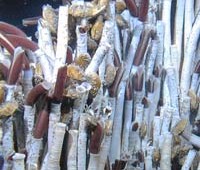Symbiosis is a tremendously creative force in evolution. Prokaryotes in particular are critical partners with eukaryotes: humans rely on symbiotic bacteria in their gut and on their skin; plants depend on symbiotic bacteria and fungi, and many if not most arthropods carry intracellular bacterial symbionts, just to name a few examples. The processes and interactions…
Why Sequence the Mating Loci of Chlamydomonas reinhardtii and Volvox carteri?
In order to understand an organism as a whole, it is essential to have a full representation of the genes used in its entire life cycle. The genome assemblies generated by JGI for Chlamydomonas reinhardtii and Volvox carteri came from a single mating type, so a large region of sequence from the opposite mating type…
Why Sequence Thellungiella halophila?
The build-up of salt in agricultural soils is a widespread problem that limits the growth and yield of important crop species worldwide. With few exceptions, crop plants are glycophytes, unable to adapt to the ionic, osmotic, and oxidative stresses induced by elevated levels of salt in the soil. Halophytes are plants that are capable of…
Why Sequence the Two-Spotted Spider Mite?
The two-spotted spider mite Tetranychus urticae belongs to the second largest group of animals, the Chelicerata, which includes spiders, scorpions, mites, and ticks. As representatives of this basal taxon of arthropods, spider mites are of special importance to several areas of science, including phylogenetics, developmental biology, evolution, ecology, and genomics. The most economically significant chelicerates…
Why Sequence Switchgrass?
A long-standing mission of the DOE has been to develop alternative sources of energy from biomass and among the targets is Switchgrass (the genome of which can be accessed at JGI’s Plant Portal, Phytozome): http://bit.ly/JGI-Switchgrass. This native grass has many traits that make it well suited for use as an energy feedstock. Yields of switchgrass are high, averaging…
Why Sequence the Deep-Sea Tubeworm Riftia pachyptila?
Primary productivity is the transformation of chemical or solar energy to biomass and supports all life on earth. Photosynthesis is light-dependent productivity that uses sunlight’s energy to fix inorganic carbon into biomass. However, some bacteria and archaea are chemosynthetic and use chemical energy for the conversion of inorganic carbon to biomass. One can measure primary…
Why Sequence the Oyster Mushroom?
Pleurotus ostreatus, the oyster mushroom, is an active lignin degrader in the forests. Lignin is the second most abundant biopolymer on Earth and its breakdown is a necessary step for making cellulose (the most abundant carbon biopolymer) accessible to further enzymatic processes. The understanding of the whole-genome regulation of P. ostreatus lignocellulolytic enzymes would facilitate…
Why Sequence Peronosporomycetes?
This project entails the sequencing of 26 individual mitochondrial genomes that reflect the diversity inherent in the Peronosporomycetes, an economically important group of lower eukaryotes traditionally referred to as oomycetes. These “protistans” are ecological equivalents of fungi and share morphological, biochemical, and molecular characteristics with the chromophytic algae as members of the newly recognized kingdom…
Why Sequence Neurospora?
Among the many candidates for genome sequencing, what makes Neurospora stand out? Most importantly for comparative biology, Neurospora species are characterized by genetic and reproductive isolation, and phylogenetic relationships among the species are well supported with carefully estimated divergence times. It is clear from studies of yeast, worms, and primates that comparative genomics is most…
Why Sequence Heterobasidion annosum?
Heterobasidion annosum s.l. is a common fungal pathogen in conifer plantations and in natural forests. Economically, annosum root rot is the most devastating disease of conifers in the northern hemisphere. Modern forest management and establishment of large-scale monocultures have contributed to an increase in disease incidence, and there is a need for new control strategies….




